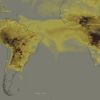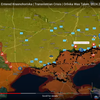Mystery of 2,000-year-old Roman concrete solved by scientists
... Some 2,000 years after they were first erected, Ancient Roman harbours made from concrete are still standing across Europe. ...
... Concrete used for ancient sea walls was made by mixing lime, seawater, volcanic ash and rock. The combination produces a 'possolanic reaction' – named after the commune of Pozzuoli in Naples.
Researchers have now discovered that elements in the ash react with sea water, which actually strengthens the material. ...
... Romans created a rock-like concrete that thrives in open chemical exchange with seawater,"...
...
Researchers discovered the Roman concrete contained aluminium tobermorite, a rare mineral that adds extra strength. When the Roman concrete was exposed to seawater, the tobermorite crystallised and spread.
The researchers said that long-term exposure to sea water helped these crystals to continue growing, reinforcing the concrete and preventing cracks from developing. ...
000
Egilsstađir, 05.07.2017 Jónas Gunnlaugsson







Bćta viđ athugasemd [Innskráning]
Ekki er lengur hćgt ađ skrifa athugasemdir viđ fćrsluna, ţar sem tímamörk á athugasemdir eru liđin.